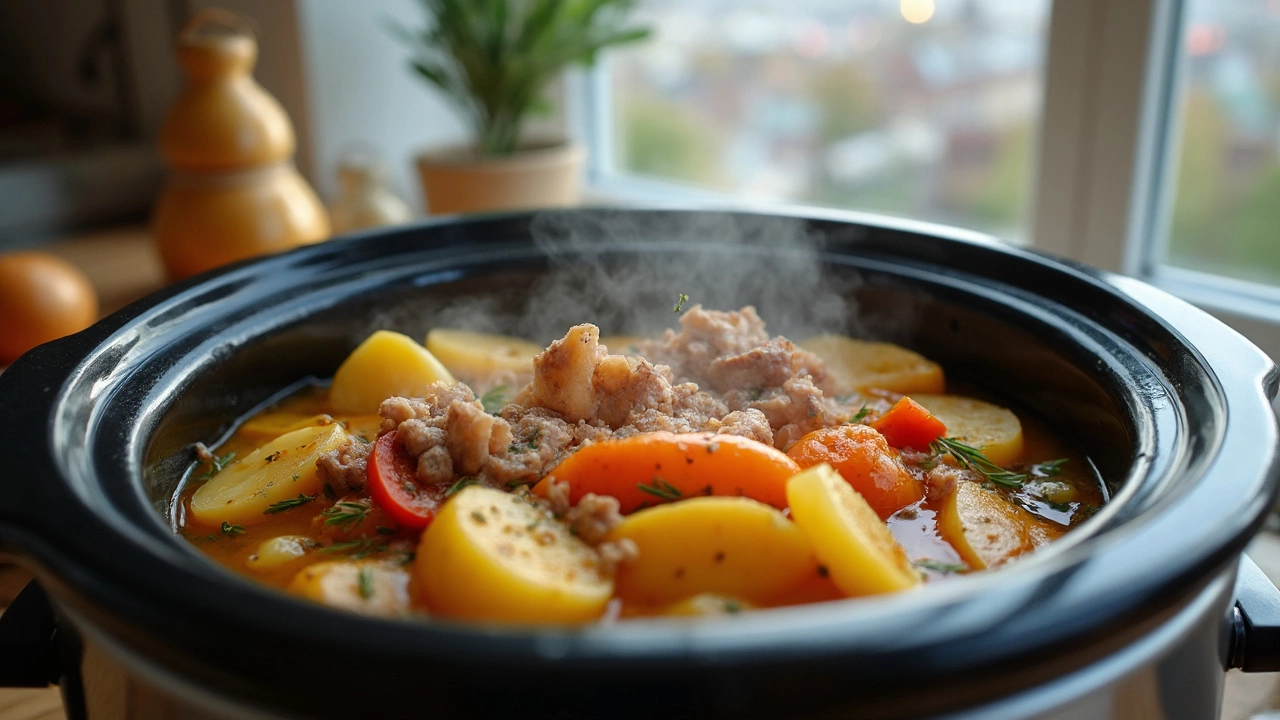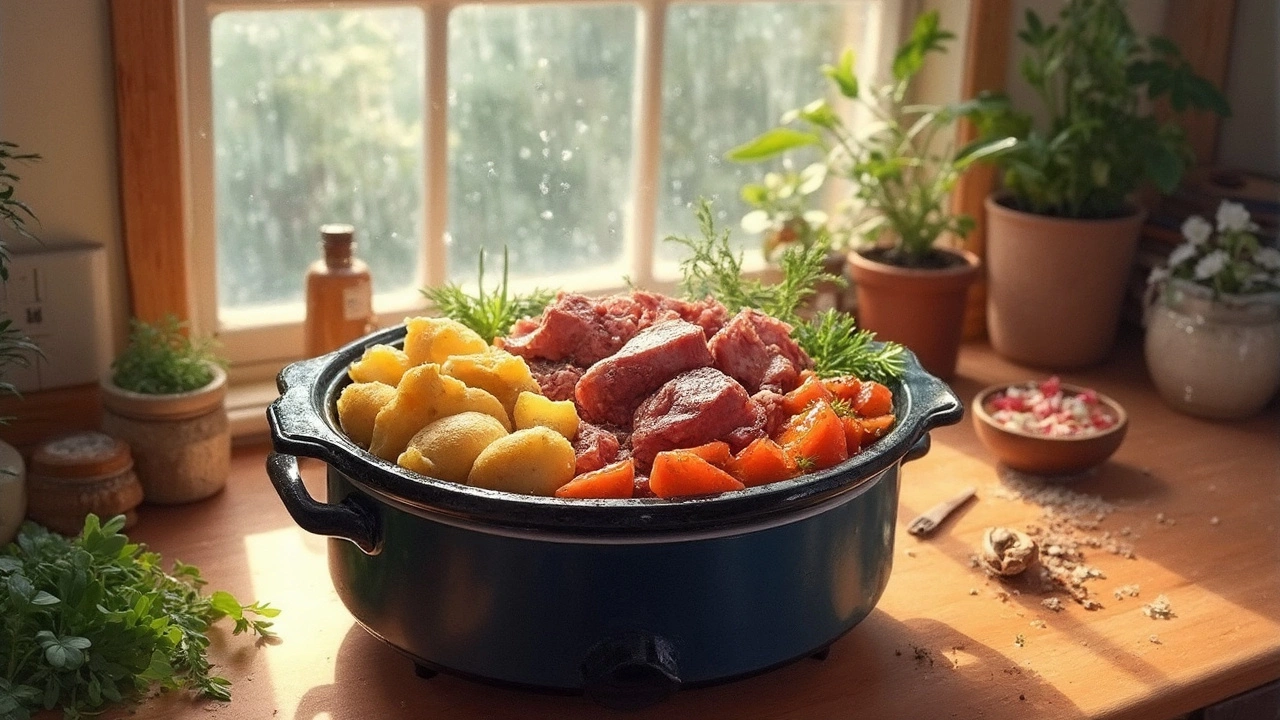Ever caught yourself just staring at your crockpot, wondering if you should plunk those potatoes on top or tuck them beneath the meat? You're not alone; we've all been there. And, believe it or not, it actually matters for your meal's flavor and texture. Crockpots are a game-changer for convenient, tasty meals, but getting the layering right is key.
Here's the lowdown: crockpots cook from the bottom up. The heat source is at the base, sending warmth up through the pot. This means ingredients touched by the base of the pot get the most heat and cook quicker. Understanding this is your first step towards crockpot mastery—placing your food strategically can make all the difference.
- Understanding Crockpot Heat Distribution
- Layering Basics: Why Does It Matter?
- The Science of Potato and Meat Placement
- Tips for the Perfect Crockpot Meal
- Common Mistakes and How to Avoid Them
Understanding Crockpot Heat Distribution
Alright, so let's talk about how your trusty crockpot actually cooks your food. The secret is in the way it distributes heat. Unlike your regular stovetop pot, a crockpot generates heat from its base and spreads it upward. This means the stuff sitting on the bottom gets the most direct heat, which can influence how fast it cooks.
Inside a crockpot, this rising heat gradually surrounds and cooks the food. That’s why placement of ingredients is a big deal. Sounds simple, right? Trust me, getting a handle on this can seriously up your slow cooker game. Understanding heat distribution helps avoid that dreaded scenario where your meat is perfect, but your potatoes are still rock-hard.
Since the heat starts low and rises, items at the bottom get hotter quicker. This makes it perfect for things like root vegetables – your potatoes, carrots, and parsnips. Placing them on the bottom ensures they cook all the way through without turning mushy before the meat gets tender.
Now, if you’re worried about your meat, here's the tip: nestled on top of the veggies, it gets gently cooked by the hot, surrounding steam and juices from below. This allows it to become tender without drying out, especially in slow-cooking recipes where moisture and even cooking are key for taste.
In essence, knowing how your crockpot works is like having a cheat sheet for better meals. Simple changes in how you layer could completely change your dinner outcome. So next time, as you layer things up, think about where the heat is coming from and how each ingredient responds to it. This way, you get not only time efficiency but also that yum-factor!
Layering Basics: Why Does It Matter?
So, why is layering in your crockpot such a big deal? Well, the whole idea is to get each ingredient to cook just right. Let’s break it down. When using a crockpot, you’re essentially slow-cooking, which means heat and time work together to meld flavors and tenderize food. But because of the heat distribution, where you place your food affects how it cooks.
Placing your potatoes on the bottom—say under the meat—is often the go-to move. Here’s why: potatoes take longer to cook than many other ingredients. By putting them on the bottom, they tap into the most intense heat, ensuring they’re done perfectly by the time everything else is ready. No one wants to bite into a raw potato, right?
On the flip side, placing meat on top allows the juices to trickle down, infusing the potatoes and other veggies with flavor. This not only makes everything taste better but also helps keep the meat from overcooking since it’s a tad further from direct heat.
Keep in mind that how you layer isn’t just about preference. It’s about optimizing cooking. Here’s a simple rule of thumb when you’re whipping up your crockpot recipes:
- Starch First: Potatoes and other root veggies go at the bottom.
- Proteins Next: Layer your meats on top.
- Veggies on High: If you're adding lighter veggies like peppers or zucchini, place them near the top. They cook fast and don’t need all that intense bottom heat.
This layering also ensures your meal has the best possible flavor balance and texture, which, after all, is the whole point of a slow cooker magic.

The Science of Potato and Meat Placement
Alright, let's get down to the nitty-gritty of crockpot cooking. The placement of potatoes and meat isn't just about preference; it's a bit of science rooted in how these ingredients cook differently.
Starting with potatoes, these starchy tubers take quite some time to cook through, especially in a slow cooker. They need direct heat to soften properly, so they do best near the bottom of the pot, closer to the heat source. This ensures they cook fully and soak up all the flavors from the meat and any seasonings you've got going.
Meat, particularly cuts like chuck roast or chicken thighs, tends to cook more evenly and stay juicier when nestled on top of the potatoes. The juices from the meat drip down as they cook, flavoring the veggies and keeping them moist. This arrangement allows for more consistent flavors throughout the dish.
Consider a typical scenario where you're cooking beef stew. Here's how you might arrange the layers:
- Base layer: Potatoes (cut into chunks) line the bottom.
- Middle layer: Vegetables like carrots and onions for added flavor complexity.
- Top layer: Meat placed on top to allow juices to seep down.
This hierarchy doesn't just help with cooking perfectly; it also gives your dish a better mix of flavors. Call it a crockpot trick, but once you nail it, you'll notice how much punchier your meals become.
Tips for the Perfect Crockpot Meal
Alright, let’s get into making your crockpot meals the talk of the block. Whether you're a seasoned slow cooker pro or just getting started, these simple tips can elevate your cooking. The right techniques can make a big difference in taste and texture, so let's get cracking!
Crockpot recipes are all about balance and timing. Here are some practical tips to get you started:
- Layering Right: Remember this rule of thumb: firmer veggies and potatoes go on the bottom, closest to the heat. Meat can go on top to ensure it stays tender and juicy, especially if it’s a cut that benefits from slower cooking.
- Preheat Your Crockpot: Just like preheating an oven, giving your crockpot a warm-up before adding ingredients can help your meal cook more evenly.
- Watch the Liquid: Crockpots don’t let moisture escape, so always add less liquid than you’d think. Too much liquid can make your meal soupy.
- Spice It Up: Add your herbs and spices early on. The long cooking process helps to really infuse those flavors into the dish.
- Leave It Alone: Avoid lifting the lid unless necessary. Every time you open it, you lose precious heat and add to cooking time.
Let’s take a quick peek at the ideal temperatures to aim for with different ingredients to ensure nothing overcooks or stays raw.
| Ingredient | Optimum Temperature (°F) |
|---|---|
| Poultry | 165 |
| Beef and Pork | 145 |
| Vegetables | 182-185 |
Pro tip: If you're going for soups or stews, consider a mix of different-cut veggies. They release flavors at different times, keeping each bite interesting.
With these tips in your pocket, your slow cooker meals are bound to impress. It’s all about getting a head start on the basics and letting time and gentle heat do the rest. Cook smart, and enjoy those melt-in-your-mouth results!

Common Mistakes and How to Avoid Them
Making a meal in your crockpot should be easy, right? But small missteps can somehow turn a culinary triumph into a bit of a letdown. So, let’s chat about some common crockpot blunders and how to dodge them.
First, one of the biggest goofs is overcrowding your crockpot. You really need space between ingredients for the heat to circulate properly. If you stuff everything in there, it's gonna turn into a soggy, unevenly cooked mess. Try to fill your crockpot about two-thirds full.
Then, there's misunderstanding the cook times. Many folks think crockpots are forgive-and-forget appliances. But cooking there's science involved! Not all ingredients need the same time to cook. Meats usually take much longer than veggies like potatoes in your crockpot. So, if you've added quick-cooking veggies like peas early on with your meat, they're gonna be mush by the end.
Another mistake? Taking the lid off too often. Each time you peek inside, a lot of heat escapes, and it takes a while to get back to the right temperature. It's like checking on cookies in the oven—just trust they’re cooking.
- Layering improperly: Place dense veggies, such as potatoes, carrots, or onions, at the bottom. This ensures they cook thoroughly since they need more time than meat.
- Adding dairy too soon: Toss in cream or cheese too early and you’re looking at curdled gunk instead of silky whatever. Add them within the last 30 minutes for the best results.
- Forgetting spices and herbs: Seasonings can mellow over long hours, leaving your dish tasting bland if you don’t use enough. Taste and adjust before serving.
But wait, it's not all doom! Here’s a bright fact: Using the right liquid is crucial too. If you skimp on the broth or sauce, your ingredients, especially meat, will dry out. Conversely, stop before it looks like soup; it’s all about balance.
To help you keep track of these essentials, here’s a little chart that could help:
| Mistake | Solution |
|---|---|
| Overcrowding | Fill only two-thirds full |
| Peeking often | Only check every few hours |
| Early Dairy | Add near end of cooking |
Nail these rules, and you’ll not only get better meals, but you’ll also make that crockpot work like a champ every time. And who doesn’t want foolproof crockpot recipes up their sleeve?

